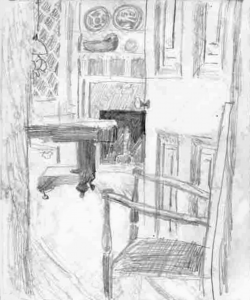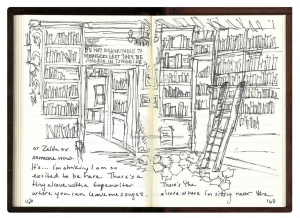For our first online project, I’m inviting you to simply draw the place where you are.
You can interpret this idea in many ways–the room or space you’re living and/or working in, a view from your room or home, a view of the interior or exterior of your home, a nearby landscape that you identify with your location, a “signature” view of your locale (like the St. Louis Arch if you were in St. Louis, for example), and so forth.
We are all experiencing major disruptions in our lives and I’d like for us to begin our online experience together by taking a moment to reflect on where we are and to share our locations, in visual terms, with one another.
You can use any drawing media on any size paper (drawing paper preferably but whatever you’ve got on hand if you’re in a pinch), in any style–contour line, a value drawing (showing lights and darks with shading), loosely or tightly drawn. Entirely up to you, as long as the drawing has a clear sense of intention and completeness. Note this quality in our Powerpoint examples, even when work is very loose.
Using a straightedge, be sure to draw a 1-2” border on your drawing before you start (1” for smaller drawings, and up to 2” for larger ones).
Although we haven’t covered value drawing (shading lights and darks) I’m guessing it’s something you’ve done before, even in your doodles. The Japanese-American sculptor Isamu Noguchi (1904-1988) once said you can learn how to do something and then do it, or do something and then learn how you did it. Given the circumstances, this is a time for the latter. What’s most important is for you to get started drawing rather than pausing to learn a technique for its own sake. Shading can be easily achieved in a pencil drawing by applying varying degrees of pressure on the pencil (always a sharp pencil), and in pen through hatching and cross-hatching, which we talked about briefly before the break. After you’ve given it a try, I’ll be happy to suggest ways of improve your technique, whichever you chose.
Another option is to include words, if you like, from the most basic label or place name to short commentary in or around the drawing, such as this one:
(But don’t draw in sketchbooks or journals; much harder to photograph. Please use a flat sheet of paper).
Finally, you can work from either life or a photo–as long as it’s a photo that you took specifically for this purpose.
You’re more than welcome do more than one drawing until you get one you like, and submit those as well.
Powerpoint
I sent a Powerpoint via email with examples and suggestions to help you get started. Be sure to have a look at it BEFORE you start drawing. There are only 19 slides, with brief captions, which take the place of the presentation I would have made in class to introduce the project.
Demos
Pencil Value Drawing: https://bowdoin.ensemblevideo.com/Watch/Xg49Kfs6
Self-Reflection and Peer Feedback
When your drawing is complete, please write a brief written response about your experience making the drawing and your thoughts about the result. This is an important chance to step back and reflect on the project. Your statement should be about 100 words and no more than 150 words.
In addition to your statement about your own work, please respond in writing to the work of two of your classmates. Be sure to include something that strikes you as very successful or appealing about the work, as well as the most important suggestion that could make it better. These comments can be directed toward any aspect of the drawing—its composition, line quality, mark-making, shading, etc. These statements should also be about 100 words and no more than 150 words.
The discussion groups for this assignment are as follows, but will rotate with each assignment to ensure a range of opinions.
Grace, Bryant, and Grace (i.e., Grace will write about Bryant and Grace, etc.)
Sara, Nate, and Devon
Isaac, Olivia, and Anika
Anibal, Ben, and Max
Aadhya, Hannah, and Ian
Ian, Ryan, and Amanda
In all cases, keep your writing informal. Do your best to let your natural voice come through in an honest and open way.
Your self-reflection is due at the same time as your drawing, no later than Thursday, April 2nd, at 5 p.m. EST, posted on Blackboard. Details to follow.
Your peer comments are due 24 hours after the drawings have been submitted, no later than Friday, April 3nd, at 5 p.m. EST, posted on Blackboard. Details to follow.
Questions and Feedback on Your Work
In addition to the written response you’ll get from me via email when the drawing is done, I’m available to answer your questions about your work in progress anytime via email, during Virtual Office Hours (our normal class time) on Zoom, or by appointment on Zoom (arranged by email).
Submitting Your Work
Once your drawing is complete, photograph and edit it based on the instructions in the How to Photograph, Edit, and Submit Your Drawings, which you’ll find in Blackboard. Details on posting your work (and your written comments) coming soon.

